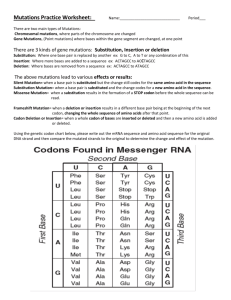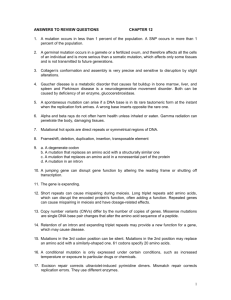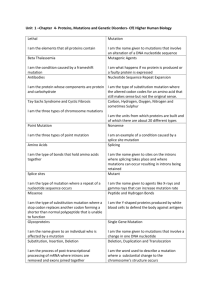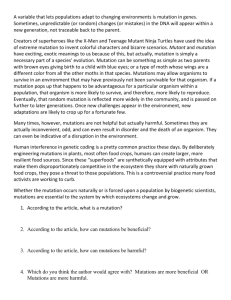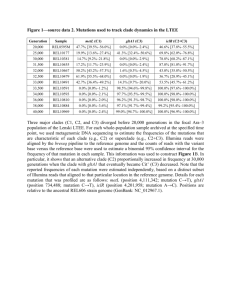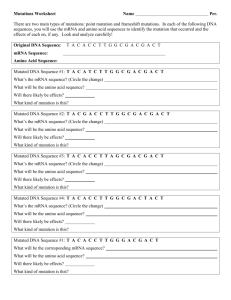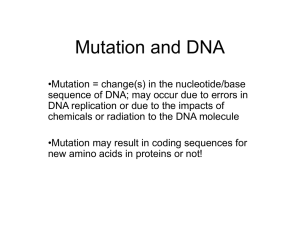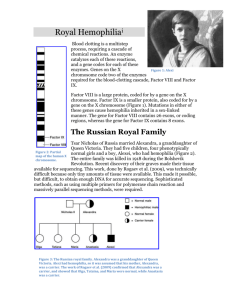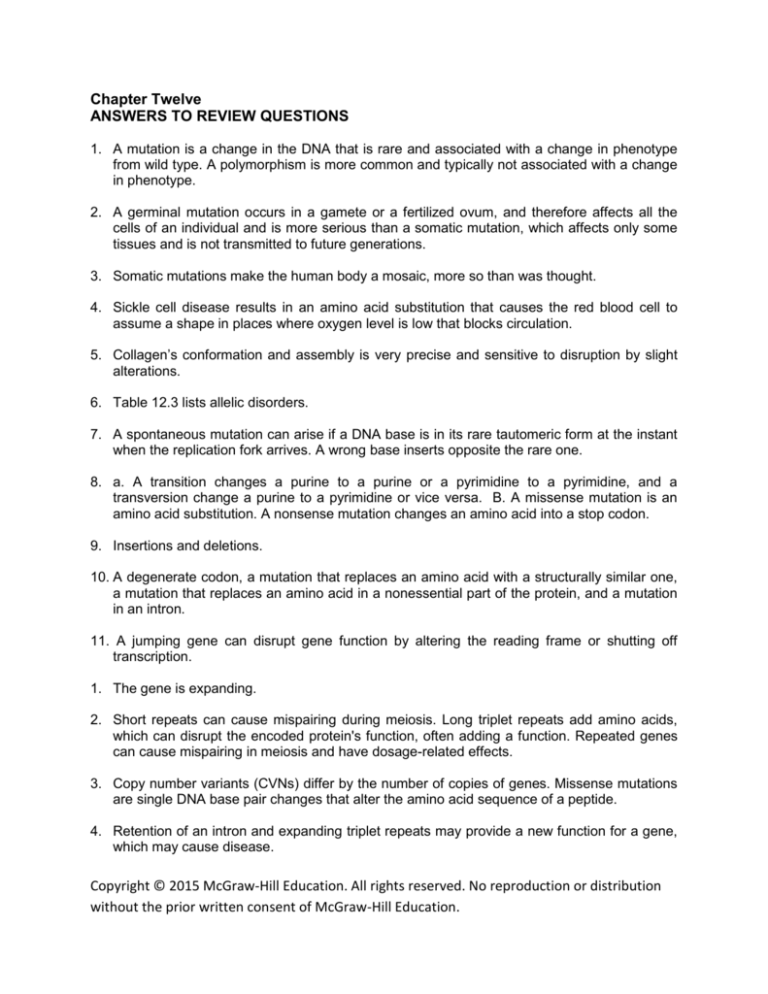
Chapter Twelve
ANSWERS TO REVIEW QUESTIONS
1. A mutation is a change in the DNA that is rare and associated with a change in phenotype
from wild type. A polymorphism is more common and typically not associated with a change
in phenotype.
2. A germinal mutation occurs in a gamete or a fertilized ovum, and therefore affects all the
cells of an individual and is more serious than a somatic mutation, which affects only some
tissues and is not transmitted to future generations.
3. Somatic mutations make the human body a mosaic, more so than was thought.
4. Sickle cell disease results in an amino acid substitution that causes the red blood cell to
assume a shape in places where oxygen level is low that blocks circulation.
5. Collagen’s conformation and assembly is very precise and sensitive to disruption by slight
alterations.
6. Table 12.3 lists allelic disorders.
7. A spontaneous mutation can arise if a DNA base is in its rare tautomeric form at the instant
when the replication fork arrives. A wrong base inserts opposite the rare one.
8. a. A transition changes a purine to a purine or a pyrimidine to a pyrimidine, and a
transversion change a purine to a pyrimidine or vice versa. B. A missense mutation is an
amino acid substitution. A nonsense mutation changes an amino acid into a stop codon.
9. Insertions and deletions.
10. A degenerate codon, a mutation that replaces an amino acid with a structurally similar one,
a mutation that replaces an amino acid in a nonessential part of the protein, and a mutation
in an intron.
11. A jumping gene can disrupt gene function by altering the reading frame or shutting off
transcription.
1. The gene is expanding.
2. Short repeats can cause mispairing during meiosis. Long triplet repeats add amino acids,
which can disrupt the encoded protein's function, often adding a function. Repeated genes
can cause mispairing in meiosis and have dosage-related effects.
3. Copy number variants (CVNs) differ by the number of copies of genes. Missense mutations
are single DNA base pair changes that alter the amino acid sequence of a peptide.
4. Retention of an intron and expanding triplet repeats may provide a new function for a gene,
which may cause disease.
Copyright © 2015 McGraw-Hill Education. All rights reserved. No reproduction or distribution
without the prior written consent of McGraw-Hill Education.
5. By altering an intron splice site so that an exon is excised.
6. Mutations in the 3rd codon position can be silent. Mutations in the 2nd position may replace
an amino acid with a similarly-shaped one. 61 codons specify 20 amino acids.
7. A conditional mutation is only expressed under certain conditions, such as increased
temperature or exposure to particular drugs or chemicals.
8. Excision repair corrects ultraviolet-induced pyrimidine dimers. Mismatch repair corrects
replication errors. They use different enzymes.
9. The parental DNA strand is retained in the stem cell.
ANSWERS TO APPLIED QUESTIONS
1. c, because it has a long repeat
2. a. AUGUCGUCAAAAGCAUGGCGGCCA, substitutes serine for leucine.
b. AUGUAGUCAAAAGCAUGGCGGCCA, changes second codon to a stop codon.
c. AUGAAUUGUCAAAAGCAUGGCGGCCA, shifts reading frame.
d. AUGUUAUCAAAAGCAUGGCGGCCA, no consequence
e. AUGUUCUCAAAAGCAUGGCGGCCA, substitutes phenylalanine for leucine.
f. AUGUUAUCAAAAGCAUGGCGGCCA, no consequence
g. AUGUUGUCAAAAGCAUGGCGGCCAAUGUUGUCAAAAGCAUGGCGGCCA
h. AUGUGUCAAAAGCAUGGCGGCCA, shifts reading frame.
3. The frameshift mutation can create a stop codon, leading to a shortened polypeptide.
4. Any change that produces UAA, UAG, or UGA
5. a.
b.
c.
d.
e.
methionine-threonine–histidine-arginine-cysteine-serine-leucine-arginine
methionine-threonine–histidine-serine-cysteine-serine-leucine-arginine
A nonsense mutation that causes a premature stop and shortens the peptide.
A frameshift mutation changes the sequence and creates a premature stop.
Insertion of two bases in a row
6. GAU to AAU or GAC to AAC
7. The second boy's second mutation, farther in the gene, restores the reading frame so that
part of the dystrophin protein has a normal structure, providing some function.
8. asn to lys: AAU to AAA AAC to AAG and for ile to thr: AUU to ACU AUC to ACC AUA
to ACA
9. A replication error may have occurred when the DNA strand being replicated looped back on
itself, or strands may have misaligned.
10. The inserted amino acid restores the reading frame and covers up the effect of the
nonsense mutation so that some protein is produced.
Copyright © 2015 McGraw-Hill Education. All rights reserved. No reproduction or distribution
without the prior written consent of McGraw-Hill Education.
11. Nonsense
12. Arg to his: CGU to CAU CGC to CAC
13. Repair enzymes could correct UV-induced pyrimidine dimers.
ANSWERS TO WEB ACTIVITIES
1. Many answers are possible.
2. a. de novo, because it is not in parents
b. The mutation creates an intron splice site.
c. Emery-Dreifuss muscular dystrophy, dilated cardiomyopathy, Dunnigan-type familial
partial lipodystrophy, limb girdle muscular dystrophy, obesity, Charcot-Marie-Tooth
disease.
3. Answers vary with image selected.
1. fragile X syndrome = 29-30 repeats of CGG is normal. 200-2000 in symptomatic
Friedreich ataxia = 6-29 repeats of GAA is normal. Affected = 200-900
Haw River syndrome = 7-25 CAGs in normal, 49-75 in affected
Jacobsen syndrome = 11 CGG in normal, 100-1,000 in affected
spinal and bulbar muscular atrophy = 14-32 CAGs in normal, 40-55 in affected
spinocerebellar ataxia = 4-44 CAGs in normal, 40-130 in affected
ANSWERS TO FORENSICS FOCUS
1. Somatic mutation
ANSWERS TO CASE STUDIES AND RESEARCH RESULTS
1. New mutation or a congenital defect that is not due to a mutant gene.
2. Genome sequencing can detect spontaneous and somatic mutations that do not affect the
phenotype and therefore are not seen clinically.
3. a. exome sequencing b. whether he inherited causative mutations c. 50%
4. Keyshauna’s case is more severe because she lacks CFTR protein, whereas Latika is
missing part of the protein.
5. They shouldn't be concerned, because they have mutations in two different genes.
6. a. Autosomal recessive. Both sexes are affected and it skips generations.
b. Consanguinity. Blood relatives share alleles inherited from common ancestors,
increasing the risk of passing the same recessive alleles to children.
c. No difference in the amino acids.
7. The second amino acid is proline in healthy members and leucine in those with heart failure.
Copyright © 2015 McGraw-Hill Education. All rights reserved. No reproduction or distribution
without the prior written consent of McGraw-Hill Education.

